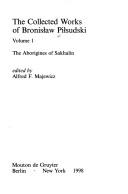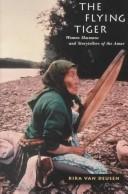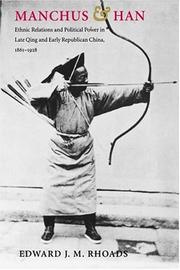| Listing 1 - 6 of 6 |
Sort by
|
Book

ISBN: 9783110205619 9783110221053 3110221055 Year: 2011 Publisher: Berlin De Gruyter Mouton
Abstract | Keywords | Export | Availability | Bookmark
 Loading...
Loading...Choose an application
- Reference Manager
- EndNote
- RefWorks (Direct export to RefWorks)
Volume 4 includes unique records of Orok (Uilta), a Tungusic language (dictionaries, texts, grammatical comments) noted down by Pilsudski directly from native informants at the beginning of the 20th century on Sakhalin. The original source material is identified with the help of - and confronted against - all the existing contemporary dictionaries with the assistance of leading specialists in the field (the Novosibirsk Avrorin group, also called the school of Manchu-Tungusologists). Abundant comparative data are quoted. All necessary introductory information and commentaries of ethnographic, h
Ethnology. Cultural anthropology --- Russian language --- Siberia --- Tungus-Manchu languages. --- Tungusic peoples --- Social life and customs. --- Endangered Languages. --- Language Contact. --- Non-Indo-European Languages.
Book
ISBN: 9004254234 9789004254237 9789004233065 9004233067 Year: 2013 Publisher: Leiden Boston Global Oriental
Abstract | Keywords | Export | Availability | Bookmark
 Loading...
Loading...Choose an application
- Reference Manager
- EndNote
- RefWorks (Direct export to RefWorks)
Evenki are modern hunter-gatherers who live in Central and Eastern Siberia, Russian Federation. They are known to scholarship for their animistic worldview, and because the word ‘shaman’ has been borrowed from their language. Despite such recognition contemporary Evenki everyday life rarely appears as a subject for anthropological monographs, mainly because access to Evenki communities for the purpose of extended fieldwork has only recently become possible. In this original study of the Evenki the authors describe a variety of events and situations they observed during fieldwork, and through these experiences document different strategies that Evenki use to retain their ethos as hunter-gatherers even in circumstances when hunting is prohibited. The authors adopt the vocabulary of cybernetics, proposed by anthropologist Gregory Bateson, in order to underline the circuit logic of events that happen in Evenki land. Culture Contact in Evenki Land , therefore, will be welcomed by social anthropologists in general and specialists of Siberian and Inner Asian studies (Manchu-Tungus peoples) and hunter-gatherer peoples in particular, as well as those interested in the cybernetic approach.
Evenki (Asian people) --- SOCIAL SCIENCE / Anthropology / Cultural. --- SOCIAL SCIENCE / Discrimination & Race Relations. --- SOCIAL SCIENCE / Ethnic Studies / General. --- SOCIAL SCIENCE / Minority Studies. --- Avanki (Asian people) --- Avankil (Asian people) --- Chapogir (Asian people) --- Ewenki (Asian people) --- Khamnigan (Asian people) --- O-wen-kʻo (Tribe) --- Owenke (Asian people) --- Owenko (Asian people) --- Tungus (Asian people) --- Tunguses --- Arctic peoples --- Ethnology --- Tungusic peoples --- Baikal, Lake, Region (Russia) --- Social life and customs.

ISBN: 311010928X 3110161184 3110176149 9783110221053 3110221055 Year: 2004 Publisher: Berlin Mouton de Gruyter
Abstract | Keywords | Export | Availability | Bookmark
 Loading...
Loading...Choose an application
- Reference Manager
- EndNote
- RefWorks (Direct export to RefWorks)
Volume 4 includes unique records of Orok (Uilta), a Tungusic language (dictionaries, texts, grammatical comments) noted down by Pilsudski directly from native informants at the beginning of the 20th century on Sakhalin. The original source material is identified with the help of - and confronted against - all the existing contemporary dictionaries with the assistance of leading specialists in the field (the Novosibirsk Avrorin group, also called the school of Manchu-Tungusologists). Abundant comparative data are quoted. All necessary introductory information and commentaries of ethnographic, h
Ethnology. Cultural anthropology --- Russian language --- Russia --- Tungus-Manchu languages. --- Tungusic peoples --- Altaic peoples --- Ethnology --- Manchu languages --- Manchu-Tungus languages --- Tungus languages --- Tungusic languages --- Altaic languages --- Social life and customs. --- J5091 --- J4207 --- J4190.80 --- J4190.85 --- Japan: Language -- minority languages in Japan -- Ainu --- Japan: Sociology and anthropology -- communities -- native ethnicity and race --- Japan: Sociology and anthropology -- local communities and culture -- Hokkaidō (Ezo) --- Japan: Sociology and anthropology -- local communities and culture -- northern territories --- Endangered Languages. --- Language Contact. --- Non-Indo-European Languages.

ISBN: 1282859129 9786612859120 0773569006 9780773569003 0773521550 0773521569 9780773521551 9780773521568 Year: 2001 Volume: 26 Publisher: Montreal McGill-Queen's University Press
Abstract | Keywords | Export | Availability | Bookmark
 Loading...
Loading...Choose an application
- Reference Manager
- EndNote
- RefWorks (Direct export to RefWorks)
Describes the lives of the people of the Amur during a period of dramatic transition, as they attempt to find some way to relate ancient traditions to an uncertain future. The author emphasizes the contributions of women in traditional and contemporary society, and their concerns with ecology and the education of children.
Tales --- Women storytellers --- Women shamans --- Evenki (Asian people) --- Femmes chamans --- Toungouses --- Légendes --- Contes --- Avanki (Asian people) --- Avankil (Asian people) --- Chapogir (Asian people) --- Ewenki (Asian people) --- Khamnigan (Asian people) --- O-wen-kʻo (Tribe) --- Owenke (Asian people) --- Owenko (Asian people) --- Tungus (Asian people) --- Tunguses --- Arctic peoples --- Ethnology --- Tungusic peoples --- Medicine women --- Shamanesses --- Shamans --- Storytellers --- Women entertainers --- Folk tales --- Folktales --- Folk literature --- Conteuses --- Evenk (Peuple d'Asie) --- Folklore. --- Folklore --- Tales - Amur River Valley (China and Russia) --- Women storytellers - Amur River Valley (China and Russia) --- Women shamans - Amur River Valley (China and Russia) --- Evenki (Asian people) - Folklore --- Legendes
Book
ISBN: 9780804798112 9781503600799 1503600793 0804798117 Year: 2017 Publisher: Stanford, Calif. Stanford University Press
Abstract | Keywords | Export | Availability | Bookmark
 Loading...
Loading...Choose an application
- Reference Manager
- EndNote
- RefWorks (Direct export to RefWorks)
From precious jade articles to monumental stone arches, Huizhou salt merchants in Jiangnan lived surrounded by objects in eighteenth-century China. How and why did these businessmen devote themselves to these items? What can we learn about eighteenth-century China by examining the relationship between merchants and objects? Luxurious Networks examines Huizhou salt merchants in the material world of High Qing China to reveal a dynamic interaction between people and objects. The Qianlong emperor purposely used objects to expand his influence in economic and cultural fields. Thanks to their broad networks, outstanding managerial skills, and abundant financial resources, these salt merchants were ideal agents for selecting and producing objects for imperial use. In contrast to the typical caricature of merchants as mimics of the literati, these wealthy businessmen became respected individuals who played a crucial role in the political, economic, social, and cultural world of eighteenth-century China. Their life experiences illustrate the dynamic relationship between the Manchu and Han, central and local, and humans and objects in Chinese history.
Merchants --- Salt industry and trade --- Manchus --- Material culture --- S04/0680 --- S10/0450 --- S10/0500 --- Culture --- Folklore --- Technology --- Manchu (Manchurian people) --- Ethnology --- Tatars --- Tungusic peoples --- Nonmetallic minerals industry --- Businesspeople --- History --- Social networks --- Kings and rulers --- China: History--Qing: general: 1644 - 1912 --- China: Economics, industry and commerce--Commerce inside China: general and before 1911 --- China: Economics, industry and commerce--Industries and industrialization: general and before 1911 (economic aspects come here) --- Huizhou Diqu (China) --- China --- Hui-chou ti chʻü (China) --- Huizhou Prefecture (China) --- Hui-chou Prefecture (China) --- Anhui Sheng Huizhou Diqu (China) --- History of Asia --- anno 1700-1799 --- Commerce --- 徽州地区 (China) --- Huangshan Shi (China : Prefecture)

ISBN: 0295997486 0295804122 0295980400 9780295804125 9780295980409 9780295997483 0295979380 9780295980409 0295804114 0295977884 0295978090 029598063X 9622095046 9882203795 Year: 2000 Publisher: Seattle : University of Washington Press,
Abstract | Keywords | Export | Availability | Bookmark
 Loading...
Loading...Choose an application
- Reference Manager
- EndNote
- RefWorks (Direct export to RefWorks)
China�s 1911�12 Revolution, which overthrew a 2000-year succession of dynasties, is thought of primarily as a change in governmental style, from imperial to republican, traditional to modern. But given that the dynasty that was overthrown�the Qing�was that of a minority ethnic group that had ruled China�s Han majority for nearly three centuries, and that the revolutionaries were overwhelmingly Han, to what extent was the revolution not only anti-monarchical, but also anti-Manchu?Edward Rhoads explores this provocative and complicated question in Manchus and Han, analyzing the evolution of the Manchus from a hereditary military caste (the �banner people�) to a distinct ethnic group and then detailing the interplay and dialogue between the Manchu court and Han reformers that culminated in the dramatic changes of the early 20th century.Until now, many scholars have assumed that the Manchus had been assimilated into Han culture long before the 1911 Revolution and were no longer separate and distinguishable. But Rhoads demonstrates that in many ways Manchus remained an alien, privileged, and distinct group. Manchus and Han is a pathbreaking study that will forever change the way historians of China view the events leading to the fall of the Qing dynasty. Likewise, it will clarify for ethnologists the unique origin of the Manchus as an occupational caste and their shifting relationship with the Han, from border people to rulers to ruled.Winner of the Joseph Levenson Book Prize for Modern China, sponsored by The China and Inner Asia Council of the Association for Asian Studies
Manchus. --- China --- Ethnic relations. --- History --- Manchu (Manchurian people) --- Ethnology --- Tatars --- Tungusic peoples --- S22/0500 --- S11/1230 --- S04/0680 --- S04/0690 --- S22/0800 --- S04/0705 --- Manchus --- North-eastern provinces (Manchuria)--History: general and before 1931 --- China: Social sciences--Others --- China: History--Qing: general: 1644 - 1912 --- China: History--Qing: 1644 - 1840 --- North-eastern provinces (Manchuria)--Social conditions (Chinese immigration and position of Manchus come here) --- China: History--Modern history, China: after 1840 --- -History --- -S22/0500 --- Cina --- Kinë --- Cathay --- Chinese National Government --- Chung-kuo kuo min cheng fu --- Republic of China (1912-1949) --- Kuo min cheng fu (China : 1912-1949) --- Chung-hua min kuo (1912-1949) --- Kina (China) --- National Government (1912-1949) --- China (Republic : 1912-1949) --- People's Republic of China --- Chinese People's Republic --- Chung-hua jen min kung ho kuo --- Central People's Government of Communist China --- Chung yang jen min cheng fu --- Chung-hua chung yang jen min kung ho kuo --- Central Government of the People's Republic of China --- Zhonghua Renmin Gongheguo --- Zhong hua ren min gong he guo --- Kitaĭskai︠a︡ Narodnai︠a︡ Respublika --- Činská lidová republika --- RRT --- Republik Rakjat Tiongkok --- KNR --- Kytaĭsʹka Narodna Respublika --- Jumhūriyat al-Ṣīn al-Shaʻbīyah --- RRC --- Kitaĭ --- Kínai Népköztársaság --- Chūka Jinmin Kyōwakoku --- Erets Sin --- Sin --- Sāthāranarat Prachāchon Čhīn --- P.R. China --- PR China --- PRC --- P.R.C. --- Chung-kuo --- Zhongguo --- Zhonghuaminguo (1912-1949) --- Zhong guo --- Chine --- République Populaire de Chine --- República Popular China --- Catay --- VR China --- VRChina --- 中國 --- 中国 --- 中华人民共和国 --- Jhongguó --- Bu̇gu̇de Nayiramdaxu Dundadu Arad Ulus --- Bu̇gu̇de Nayiramdaqu Dumdadu Arad Ulus --- Bu̇gd Naĭramdakh Dundad Ard Uls --- BNKhAU --- БНХАУ --- Khi︠a︡tad --- Kitad --- Dumdadu Ulus --- Dumdad Uls --- Думдад Улс --- Kitajska --- China (Republic : 1949- ) --- -Manchus. --- Asian history --- -Manchus
| Listing 1 - 6 of 6 |
Sort by
|

 Search
Search Feedback
Feedback About UniCat
About UniCat  Help
Help News
News